Recent Articles
Popular Makes
Body Types
2015 Hyundai Genesis 3.8 Review and Quick Spin
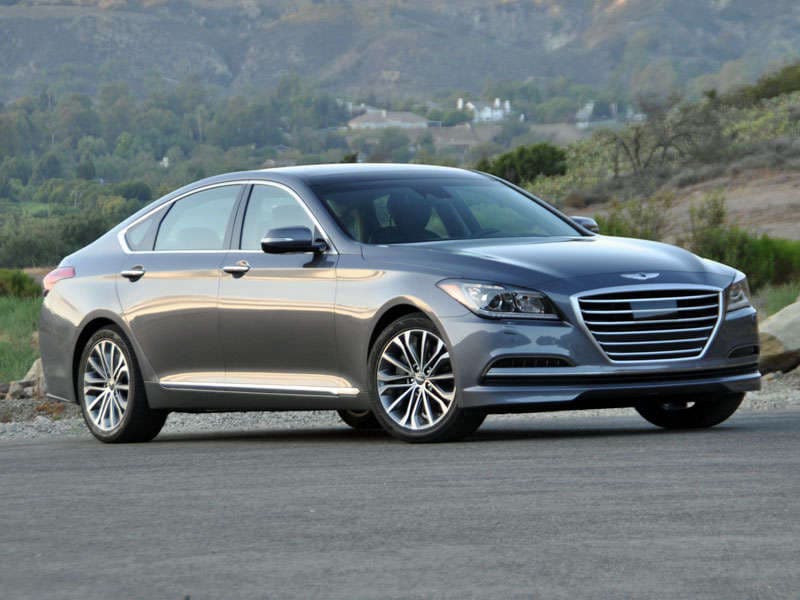
2015 Hyundai Genesis 3.8 Empire State Gray Front Quarter Right ・ Photo by Christian Wardlaw
When Hyundai introduced the original Genesis, the company needed to make a decision: launch the car with a luxury nameplate and incur all of the costs associated with establishing a new brand, or introduce it as a premium car wearing a mainstream badge.
Hyundai elected to conserve cash and take a risk, and as a result, it is now proving that upscale, luxurious, high-quality cars need not wear a special emblem in order to justify their existence.
Having now spent a week driving the Genesis, I can assure you that this is a full-fledged luxury sedan in every sense, a genuine bargain when stacked up against equivalently outfitted versions of an Audi A6, a BMW 5 Series, a Cadillac CTS, a Mercedes E-Class, or a Lexus GS.
2015 Hyundai Genesis 3.8 Review and Quick Spin: About Our Test Car
This is one of six sedans that Hyundai sells, slotting into the lineup between the Azera full-size sedan and the Equus luxury flagship model. Prices start at less than $40,000 for the V-6 powered Genesis 3.8, and rise to nearly $56,000 with all the option boxes checked for a V-8 powered Genesis 5.0.
My test car is the Genesis 3.8 with all-wheel drive, painted Empire State Gray. It is loaded with every option, and costs $52,450, which is less than a Mercedes-Benz E350 without a single option added. And Mercedes charges extra for luxury sedan basics like metallic paint and leather. Even a reversing camera is optional on a Benz.
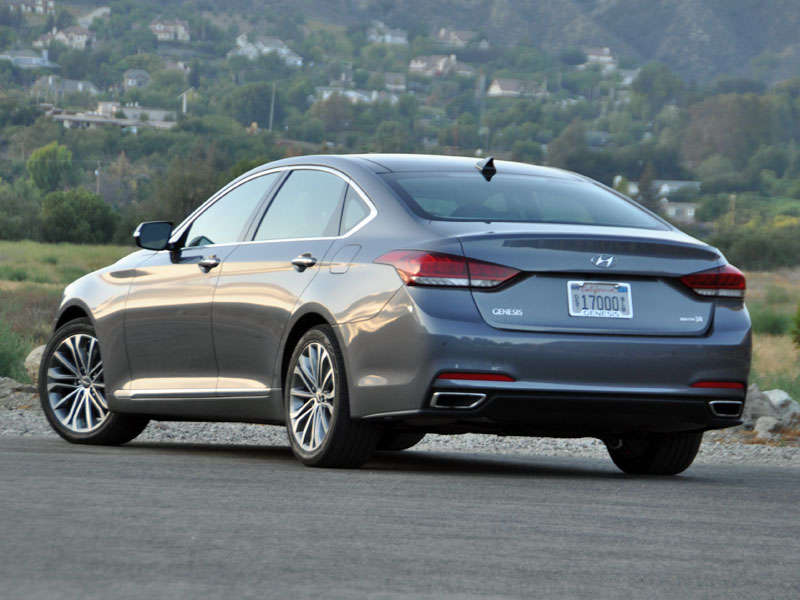
Photo by Christian Wardlaw
2015 Hyundai Genesis 3.8 Review and Quick Spin: Styling and Design
I also happen to think that the Genesis is better looking than the Mercedes. It is long, lithe, sleek, with very little front overhang and a cabin that sits far back on the chassis. Admittedly, the styling is derivative of a number of other cars, but this collection of familiar themes is undeniably appealing and is likely to age well. I’ll say this, too: lots of people noticed this car.
One thing I’d change, though, is the thin-spoke wheel design on my test car. A loaded Genesis 3.8 really ought to have the same wheels as the Genesis 5.0. They look terrific, and buyers ought not be forced into getting the most powerful and least efficient engine in order to enjoy the nicer rims.
By the way, except for the Hyundai corporate logo on the trunk, every Bentleyesque badge on this car says Genesis.
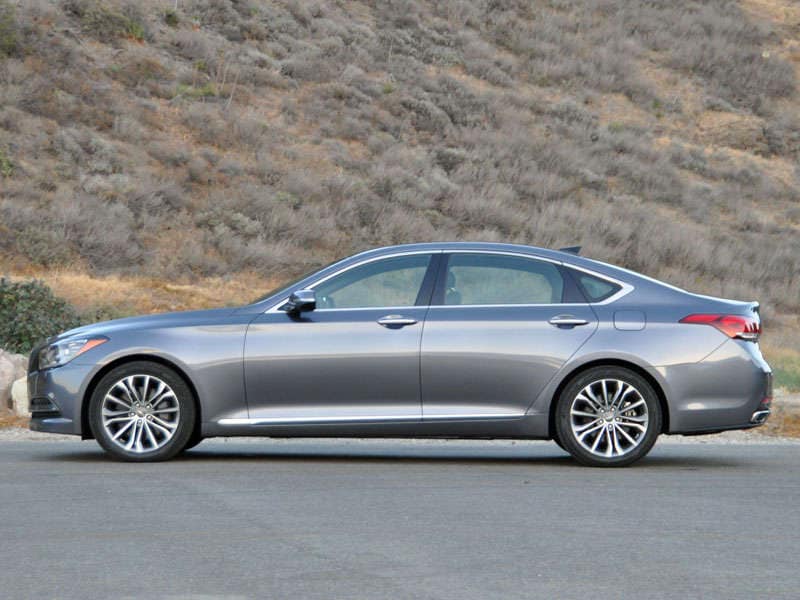
Photo by Christian Wardlaw
2015 Hyundai Genesis 3.8 Review and Quick Spin: Front Seat Comfort
When getting into or out of the Genesis, you’ve gotta watch your head on the rakish roofline, especially if you like to sit up nice and high like I do.
Once you’re in, though, there are no comfort issues at all. My test car’s driver’s seat provides multiple power lumbar adjustments, a power thigh support extension, and even power adjustable side bolsters.
The front seat belt buckles are rather floppy, though, and I sometimes had a hard time getting the latch into the buckle.
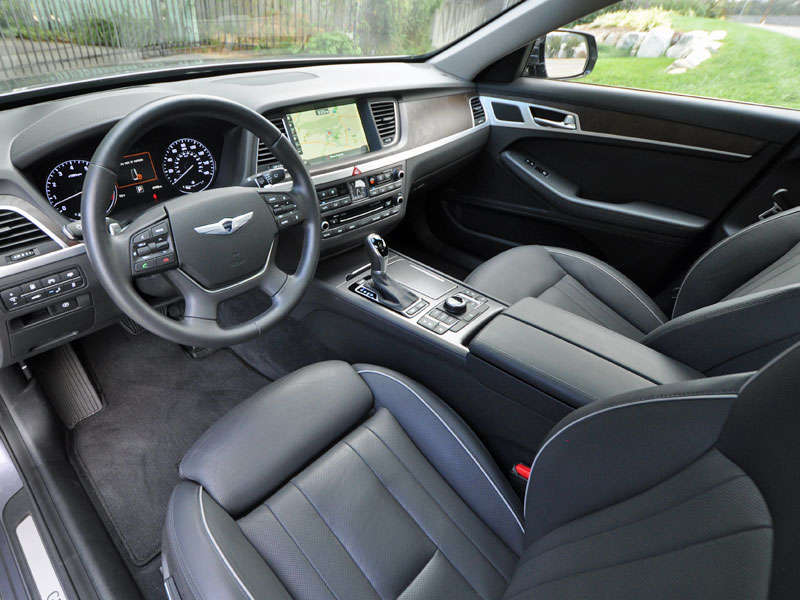
Photo by Christian Wardlaw
2015 Hyundai Genesis 3.8 Review and Quick Spin: Rear Seat Comfort
Occupants sit a little bit low in the Genesis Sedan’s back seat, but that just means you’ll need to exert a little more effort when getting yourself out. In all other aspects, this rear seat is exceptionally comfortable, soft and soothing without lacking support. I could ride back here for miles and miles and miles.
My test car had manual side window shades and a power rear window shade. Better yet, the giant center armrest contains cup holders, individual rear seat heaters, and a button to control the rear window shade. All that’s really missing are rear seat ventilators for hot, muggy days.
Parents of smaller children will want to note that I really struggled to get my 3-year-old’s forward-facing car seat cinched down tight enough. It wasn’t easy with my particular safety seat design.
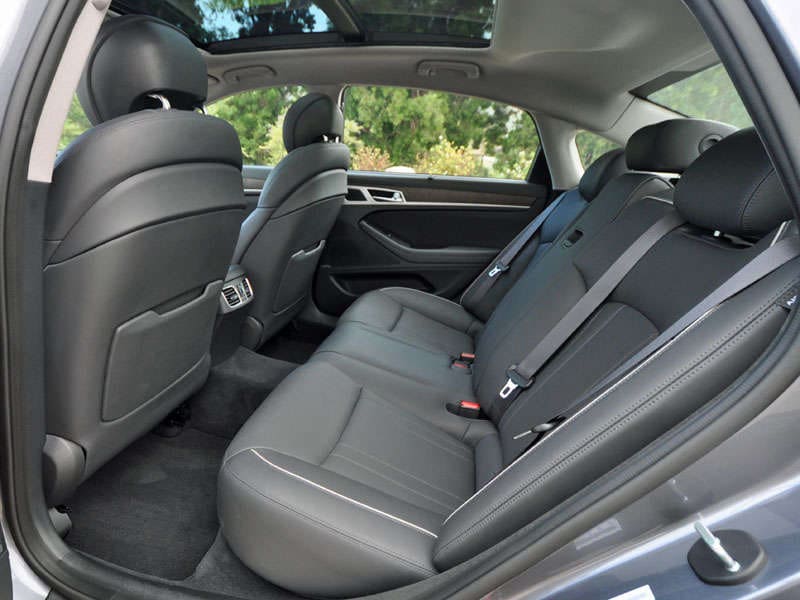
Photo by Christian Wardlaw
2015 Hyundai Genesis 3.8 Review and Quick Spin: Trunk Room
The Genesis provides a good-size trunk, one measuring 15.3 cu.-ft., and it has a handy hook for carrying plastic grocery sacks or shopping bags. Approach the car with full arms, and a Smart Trunk feature automatically opens the trunk lid if you stand behind the car for a few seconds.
To expand cargo room, use the rear-seat pass-through, but if you’re looking for folding rear seat backs, you’ll be disappointed. Closing the trunk is easy, thanks to my test car’s power closing function.
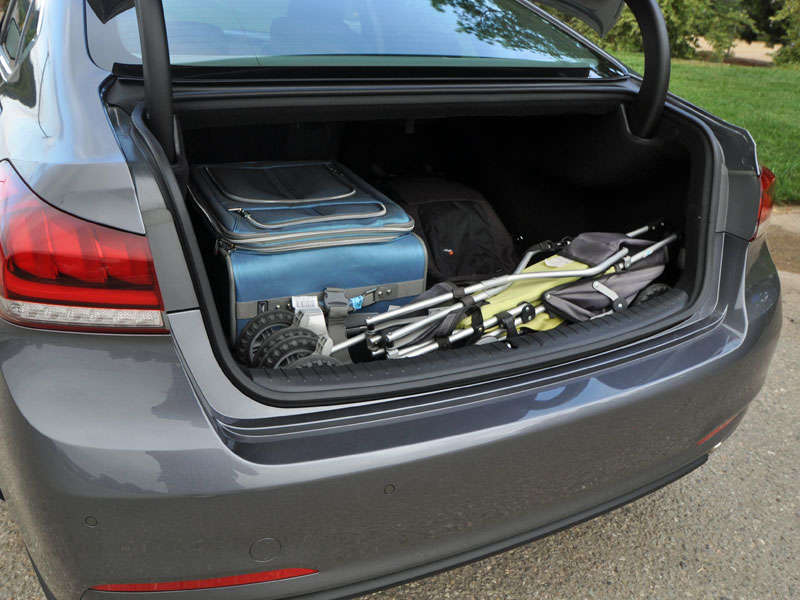
Photo by Christian Wardlaw
2015 Hyundai Genesis 3.8 Review and Quick Spin: Features and Controls
When you buy a midsize luxury sedan, you can pay for a name, like Audi, or BMW, or Cadillac, or Lexus, or Mercedes, or you can buy this Hyundai and get a whole bunch of stuff instead of a prestigious badge.
Remember, my test car has every bell and whistle on it, and it is still less than a base E-Class without a single upgrade. It’s got matte-finish wood and real aluminum trim, high-end leather, ventilated front seats, a panoramic sunroof, a 17-speaker surround sound audio system that could easily deafen you (and without distortion), a premium navigation system with a 9.2-inch display, rear and side window shades, and every safety feature Hyundai could throw at it.
Seriously, when it comes to deciding between the Hyundai Genesis and any other midsize luxury sedan, you’ve gotta ask yourself: what would Warren Buffet do?
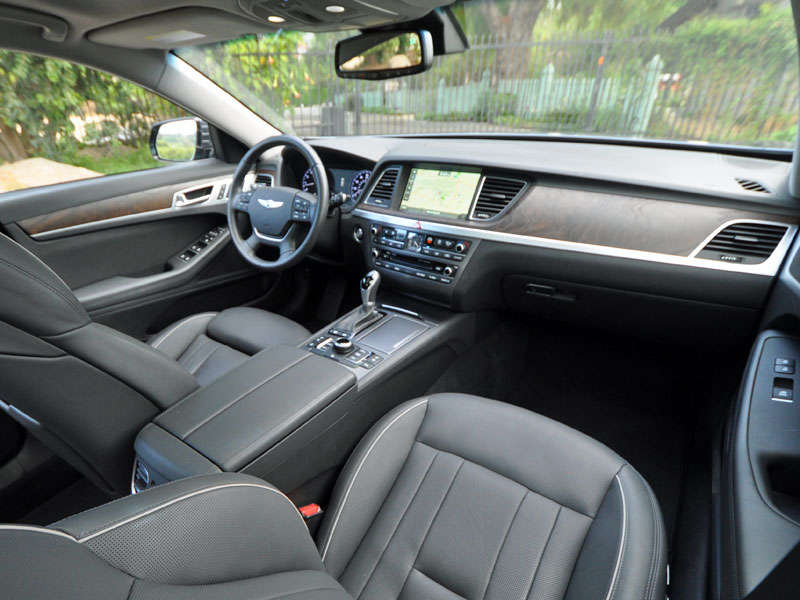
Photo by Christian Wardlaw
2015 Hyundai Genesis 3.8 Review and Quick Spin: What's Under the Hood
Hyundai offers the Genesis with a choice between a 311-horsepower, 3.8-liter V-6 engine and a 420-horsepower, 5.0-liter V-8 engine. All Genesis models get an 8-speed automatic transmission and rear-wheel drive, and all-wheel drive is optional for the first time, which ought to increase the car’s appeal in Snowbelt states.
According to the EPA, the Genesis 3.8 is rated to get 22 mpg in combined driving, while the Genesis 5.0 returns 18 mpg. If you don’t need it, skip the all-wheel-drive system: it drops fuel economy by 3 mpg.
My test car had AWD, and suffered for it. I averaged just 18.4 mpg during a week of driving. The good news is that my experience and the EPA’s rating of 19 mpg are in the same neighborhood, so the official numbers appear to be accurate.
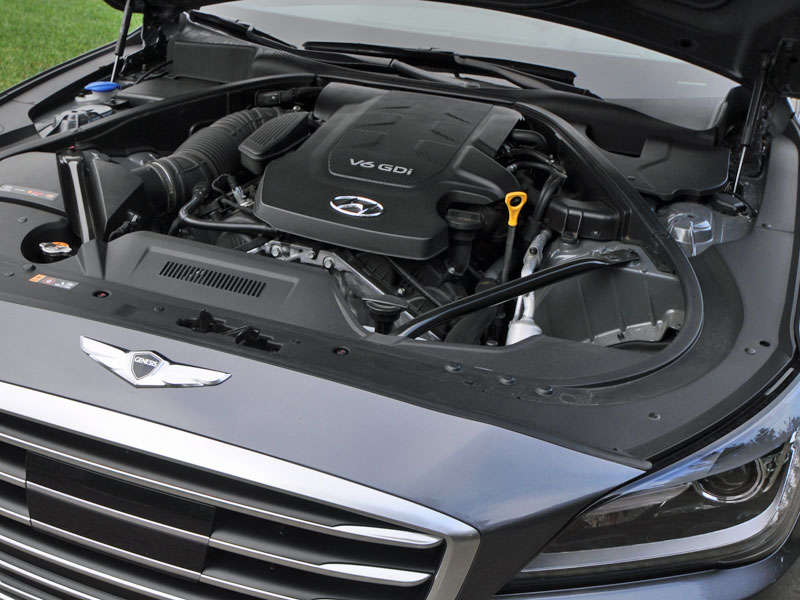
Photo by Christian Wardlaw
2015 Hyundai Genesis 3.8 Review and Quick Spin: Driving Impressions
Get behind the wheel of the new Genesis, and it doesn’t take long to figure out that Hyundai engineers spent lots of time tuning this car’s powertrain. Whether you’re accelerating gently or stomping on the gas, this car responds exactly as you expect…most of the time.
On one occasion, when I wanted to switch lanes and get myself out of a thick pack of slow-moving vehicles, the 8-speed automatic transmission took its sweet time figuring out what gear to choose, and then shifting into that gear. But otherwise, the quiet, refined, and powerful V-6 delivered exceptional performance.
The suspension, too, is calibrated to isolate the car’s occupants from noise and jostling while still communicating enough surface texture so that the driver knows what is happening at each contact patch. Still, while ride quality is on the firm side, this example of the Genesis is not really a sport sedan. It would need a tighter suspension, improved roll control, and stickier tires to qualify for that designation.
Generally, the brakes work well, resisting fade and faithfully bringing the car to smooth stop. Pedal calibration leaves something to be desired, though. It feels a little mushy, and after one occasion when I needed to jam on the pedal to avoid another motorist who decided to jump into my lane right after I began to accelerate, I lacked confidence in the brakes. In that situation, they required too much pressure and pedal travel to bring the car to a sudden halt. I wanted swift and immediate braking in that situation, and that’s not what I got.
Hyundai also needs to work on fine-tuning the Genesis Sedan’s steering. Around town, in the suburbs, and on the freeway, it’s fine, feeling hefty in the driver’s hands, and responsive for that type of driving. On higher-speed bends in a country highway, and when threading S-curves on a favorite twisty two-lane road, the steering feels sticky, resisting the driver’s fine-tuning effort in mid-corner.
If it sounds like I didn’t like driving the Genesis, that’s not true. It is better than any Hyundai I’ve ever driven, and is more engaging and entertaining than many of its direct competitors. But engineers definitely need to continue honing the brakes and steering so that when they draw attention to themselves it with delight rather than distaste.

Photo by Christian Wardlaw
2015 Hyundai Genesis 3.8 Review and Quick Spin: Final Thoughts
Where I live, lots of people spend lots of money buying cars they don’t need or want, and for no other reason than they are “the best.”
If it even makes the consideration list, the redesigned Hyundai Genesis Sedan forces a luxury sedan buyer to think hard about his or her priorities, and even to face personal demons like envy and insecurity. That’s because this car is a genuine luxury sedan. All that’s missing is the genuine luxury sedan badge.
Hyundai provided the 2015 Genesis Sedan for this review
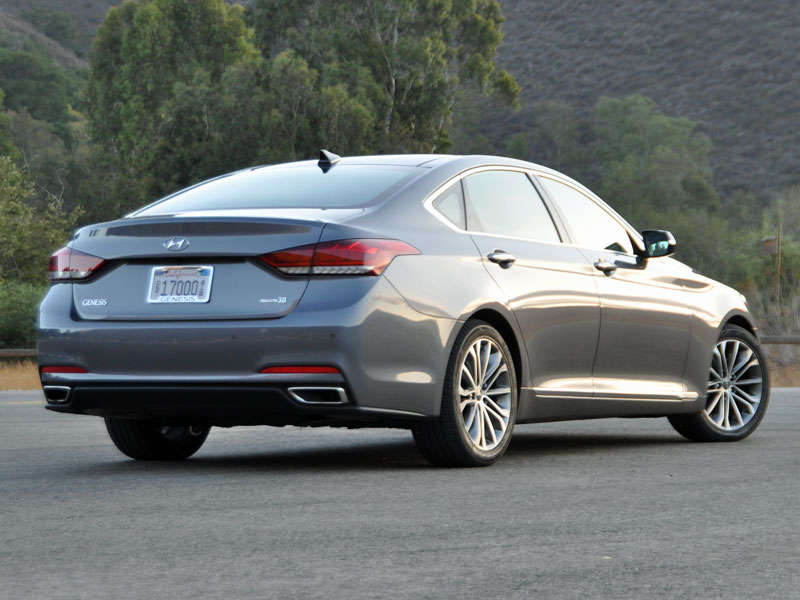
Photo by Christian Wardlaw